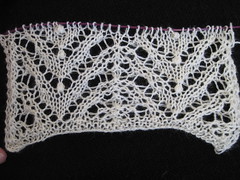 It never ceases to amaze me what a difference it makes to block lace projects. Some lace knitters I know think that blocking the final piece is the best part of making a lace shawl, because you can really see how the pattern opens up. I’m not quite that enthusiastic about it myself. I mean, I really DO love to see the lace open up, and to see the completed shawl in all its glory. On the other hand, threading the blocking-wires and pinning the shawl out on a bed in the basement is not all that enjoyable either. Usually it’s something I do when I’m at home by myself (so I don’t get interrupted).
It never ceases to amaze me what a difference it makes to block lace projects. Some lace knitters I know think that blocking the final piece is the best part of making a lace shawl, because you can really see how the pattern opens up. I’m not quite that enthusiastic about it myself. I mean, I really DO love to see the lace open up, and to see the completed shawl in all its glory. On the other hand, threading the blocking-wires and pinning the shawl out on a bed in the basement is not all that enjoyable either. Usually it’s something I do when I’m at home by myself (so I don’t get interrupted).
Now, going back into the basement the next day to unpin the blocked piece….. THAT’S enjoyable. 
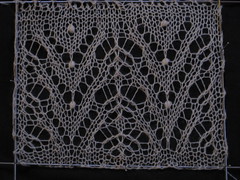 These two pictures show the same lace swatch, first unblocked, and then blocked. My lace tends to grow a lot more length-wise when I block it. This particular swatch almost doubled in height when wet-blocked. And the lace pattern opens up and you can really see the design.
These two pictures show the same lace swatch, first unblocked, and then blocked. My lace tends to grow a lot more length-wise when I block it. This particular swatch almost doubled in height when wet-blocked. And the lace pattern opens up and you can really see the design.
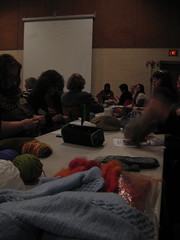 This week it was time for another meeting with the Ottawa Knitting Guild. This month there was a presentation on using the public library as a knitting resource. I’m not sure about the libraries where you live, but the Ottawa public library actually has quite a few knitting books, and I used to request stitch-dictionaries from them all the time. (And then I realized that I use them a LOT, so now I have a library of my own, *ahem*). I have also requested various pattern books when I’ve seen things that I just want to take a closer look at but not necessarily own.
This week it was time for another meeting with the Ottawa Knitting Guild. This month there was a presentation on using the public library as a knitting resource. I’m not sure about the libraries where you live, but the Ottawa public library actually has quite a few knitting books, and I used to request stitch-dictionaries from them all the time. (And then I realized that I use them a LOT, so now I have a library of my own, *ahem*). I have also requested various pattern books when I’ve seen things that I just want to take a closer look at but not necessarily own.
It was a nice, relaxing evening, and as always my favourite part is to look at all the fabulous knits, and spending time with other knitters. During the show and tell we saw a number of shawls, a clown, scarves, and clothing in various sizes (from Barbie-sized to adult). I also got to see a baby-cardigan (the blue one in the picture) with reversible cables along the front, AND all that orange fluff behind it. The fluff is of course fibre, and Natalie Servant was spinning with her new drop spindle. She claims that it’s a lot of fun, and rather relaxing. Me – I’m afraid to try it. I really don’t think I have time to take up spinning. But the fluff is nice and soft. Like clouds…..
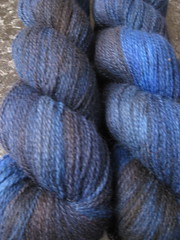 The lighting in the room is rather poor, so I really picked a bad project to work on for myself. I decided it was time to cast on for a new shawl in my new yarn from Hedgehog Fibres – Pure Cashmere lace weight in the colour ink. The colour is really delightful and I’m really looking forward to knitting with it. However, while it may look blue-black in the picture, I assure you that in poor lighting it seemed like it was black. And casting on and counting and recounting stitches, and then establishing the pattern is just not a good choice for those conditions. Oh well – next time I’ll have to bring something in a much lighter colour.
The lighting in the room is rather poor, so I really picked a bad project to work on for myself. I decided it was time to cast on for a new shawl in my new yarn from Hedgehog Fibres – Pure Cashmere lace weight in the colour ink. The colour is really delightful and I’m really looking forward to knitting with it. However, while it may look blue-black in the picture, I assure you that in poor lighting it seemed like it was black. And casting on and counting and recounting stitches, and then establishing the pattern is just not a good choice for those conditions. Oh well – next time I’ll have to bring something in a much lighter colour. 

Princess Cottongrass (Prinsessan Tuvstarr och Älgen Skutt) is the second shawl in the Fairy Tale KAL. The shawl design is based on a Swedish Fairy Tale about a princess who had never left the dream castle before. She meets Long-Leg Leap, the elk, and he takes her out to see the world. In the deep, dark forest they encounter fairies and other mythical creatures, and Princess Cottongrass loses her crown, her dress, and finally her heart.
On the shawl we can see trees (representing the forest) and her crown. The scalloped edge which is reminiscent of the Princess’ dress, and of course the hearts for her lost heart. The shawl is knit from the edge up towards the neck. This is actually the first shawl I’ve designed using this particular construction. I’ve always been a little hesitant to start with casting on lots and lots of stitches, but I have to say that it’s really nice to knit a shawl like this, because every row gets shorter and shorter (= faster and faster) so it feels like it’s knitting up really quickly.

The Princess Cottongrass shawl is knit in a brown colour that captures the colour of the tree trunks in the forest, and the colour of Princess Cottongrass’ companion, Long-Leg Leap. The colour Woodsy was especially created for this shawl by Roxanne at Zen Yarn Garden, and the yarn used was Serenity Silk III.
The pattern is currently only available as a part of the Fairy Tale KAL.
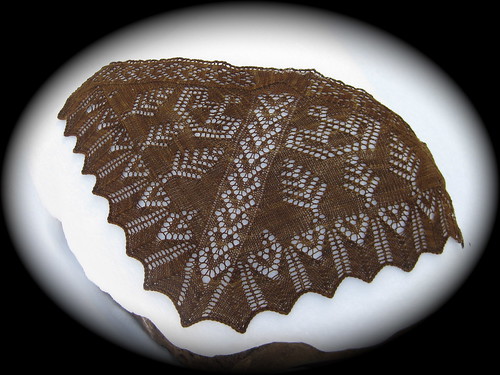
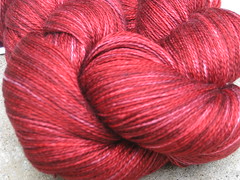 The third and final pattern in the Fairy Tale KAL will be based on a Persian Fairy Tale from the Arabian Nights – Ali Baba and the Forty Thieves. The pattern will be available to the KAL participants on Feb 15. It’s knit in Silk Lace from Sundara Yarn. 1 skein of Silk Lace in Ruby Port, or perhaps Turning Leaves or Fire Studies.
The third and final pattern in the Fairy Tale KAL will be based on a Persian Fairy Tale from the Arabian Nights – Ali Baba and the Forty Thieves. The pattern will be available to the KAL participants on Feb 15. It’s knit in Silk Lace from Sundara Yarn. 1 skein of Silk Lace in Ruby Port, or perhaps Turning Leaves or Fire Studies.
In a town in Persia lived two brothers, one named Cassim and the other Ali Baba. Cassim was married to a rich wife, while Ali Baba had to support his wife and children by cutting wood in a nearby forest. One day when Ali Baba was in the forest, he saw a group of men on horseback. He was afraid they were robbers, and hid from them. The men came into the clearing, dismounted and the leader went in amongst some bushes and said: “Open, Sesame!” so clearly that Ali Baba heard him. A door opened in the rock and the group went inside. The door shut itself again. and after some time the door opened and the men came out. After the last one had exited, the leader said “Shut, Sesame!” Then the men mounted their horses and rode off.
Ali Baba came out from his hiding place and went to the hidden door and said “Open, Sesame!” and stepped inside. He was amazed to find a cave full of riches – silk, gold and silver in heaps, and money. He brought out as many bags of gold as he thought his mules could carry, and hid it under the branches he had chopped down during the day. Then he said “Shut, Sesame!” and went home.
When he came home he showed his wife the gold and asked her to keep it a secret, and that they should bury the gold. “Let me first measure it” said his wife. “I will go borrow a measure from your brother while you dig the hole.” So she ran off to borrow a measure. But Cassim’s wife was curious to see what sort of grain she was measuring so she but some wax on the bottom of the measure before giving it to her. Ali Baba’s wife ran home and measured all the gold, and then brought it back to her sister in law, without noticing that a piece of gold was stuck to the bottom. When Cassim’s wife saw the gold she told Cassim, and Cassim confronted Ali Baba. When he found out about the treasure, he too wanted to visit the cave. Ali Baba, out of kindness more than out of fear, told him of the cave and the words to use.
Cassim set out the next morning to get treasure for himself. He soon found the place and said “Open, Sesame!” and the door opened and shut behind him. He gathered as much treasure as he could carry, but when it was time to go, he could not remember what to say. Instead of Sesame, he said “Open, Barley!” but the door remained shut. He named all sorts of different grains, all but the right one, but he was stuck.
Later that day, the robbers came to the cave and discovered Cassim there. They killed him and cut his body into four quarters and hung them up inside the cave, in order to frighten anyone who might venture in.
When Cassim hadn’t returned home in the evening, Ali Baba was worried, and set out to search for him. The first thing he saw when entering the cave was his dead brother. Full of horror, he cut the body home and brought him home. When he entered his home, the door was opened by the slave Morgiana, whom he knew to be both brave and cunning. They knew that they could not let the neighbours know of Cassim’s fate, as word might spread to the robbers. So the next day, Morgiana set out to get medicine for Cassim, and spread the word that he was ill. Therefore, in the evening, no one was surprised to hear the miserable cries and shrieks from Cassim’s wife and Morgiana, telling everyone that Cassim was dead. The next day, Morgiana went to an old cobbler, gave him a piece of gold and asked him to follow her with a needle and thread. Having blindfolded him, she took him to Cassim and asked him to sew the quarters together, and then brought him back home blindfolded. They then buried Cassim.
When the robbers returned to their cave and found that Cassim’s body had been removed, they realized he must have had an accomplice. They sent in a robber to the city, disguised as a traveler, and he just happened to come upon the cobbler. The thief asked him “Old man, how can you possibly see to stitch at your age?” “Old as I am” answered the cobbler” I have very good eyes. Will you believe me when I tell you that I sewed a dead body together in a place where I had less light than I have now?” The robber was delighted at his good fortune, and offered him a piece of gold in exchange for the location of the house where he stitched up the dead body. The cobbler replied that he had been blindfolded, but in exchange for another piece of gold, he donned another blindfold and managed to walk to the right house. The robber marked the door of the house with a piece of chalk, and decided to return in the evening with the other robbers. Morgiana happened to see the chalk mark, and quickly realized that some trouble was brewing. She fetched a piece of chalk and marked all the other doors in the neighbourhood.
In the evening when the robbers returned, they couldn’t find the right house. The leader was furious, and the robber was beheaded in the evening for having failed. The next day, another robber was sent to the city. Having won over the cobbler, he found the house and marked it by chipping out a piece of the gate. But Morgiana was too clever for the robbers and chipped out a matching piece of each of the gates in the neighbourhoods. So the second robber was also put to death.
The leader resolved to go himself the next day. But since he was wiser than the others, he did not mark the house, but looked at it so closely that he could not fail to remember it. Then he returned to his robbers and ordered them to go to neighbouring villages and purchase 19 mules and 38 barrels – all empty except one, which was full of oil. He put one of his men, fully armed, into each, rubbing the outside of the barrels with oil from the full barrel. Then the mules were loaded with thirty-seven robbers in barrels and a barrel of oil, and they reached Ali Baba’s town by sunset. The leader stopped his mules in front of Ali Baba’s house, and approached Ali Baba. “I have come to sell oil in the market tomorrow, but it is now so late that I don’t know where to spend the night, unless you would do me the favour of taking me in.” Ali Baba did not recognize the leader in his disguise, and welcomed the oil merchant into his home. He asked Morgiana to prepare a bed and supper for his guest. He then kept his guest company.
Morgiana prepared the guest room for the oil merchant, but while doing so her lamp went out, and she had no more oil in the house. One of her fellow slaves suggested she take some from one of the barrels belonging to the oil merchant. When she came close to the first barrel, the robber inside whispered “Is it time?” Any other slave would have screamed, but she quickly though of a plan and answered quietly “Not yet, but very soon.” She went to all the barrels, giving the same answer, and finally she came to the barrel of oil. She realized that her master had let 38 robbers into his house. She filled her oil pot, went back to the kitchen, and filled a large kettle with oil. When it boiled she went and poured enough oil into every barrel to stifle and kill the robber inside.
Shortly thereafter, Ali Baba called on Morgiana to entertain him and his guest. Morgiana performed an elaborate dance with a dagger, and brought it close to Ali Baba several times during the dance. As she approached the oil merchant, she stabbed him with her dagger and he fell dead to the floor. Ali Baba was appalled until Morgiana explained that the oil merchant was a robber in disguise who had brought 37 more robbers into the house to kill Ali Baba. Ali Baba thanked her, and gave Morgiana her freedom and offered her to his son in marriage, saying he owed her his life. He told his son the secret of the cave, which his son handed down in turn to his children and grandchildren. So the heirs of Ali Baba were rich to the end of their lives.
 So the time had finally come to replace my knitting bag. For the past few years, I’ve had a delightful bag from Mina Widén that was actually especially designed for me. The model was called flip-flap, as the lid just closed by flapping over. The exterior was black and discreet, and looked very stylish, if I do say so myself, and the inside was lined with pink, yellow and brown trolls that made me smile every time I looked inside. The bag has been everywhere with me, including on our trip to India, Geneva, various places in Canada and the US. And of course all around Ottawa and surroundings, and all the hockey arenas around.
So the time had finally come to replace my knitting bag. For the past few years, I’ve had a delightful bag from Mina Widén that was actually especially designed for me. The model was called flip-flap, as the lid just closed by flapping over. The exterior was black and discreet, and looked very stylish, if I do say so myself, and the inside was lined with pink, yellow and brown trolls that made me smile every time I looked inside. The bag has been everywhere with me, including on our trip to India, Geneva, various places in Canada and the US. And of course all around Ottawa and surroundings, and all the hockey arenas around. 
Unfortunately, it’s been so well used that I’ve worn it out from the inside. The lining is completely worn through in several places, and each time I use it, it only gets worse. At some point, I’m hoping to be able to replace the entire lining and give the bag new life, but sewing is not one of my specialties, and I’m still working up the courage to do it.
In the meantime, I decided to start looking for a brand new knitting bag. I looked all over the place, but with the help of some Ravelry friends (in particular Marylu and Katey), I found the Swift bag from Tom Bihn. They were both very helpful in answering all my questions about the bag, and in the end it seemed that it would be very well suited for me.
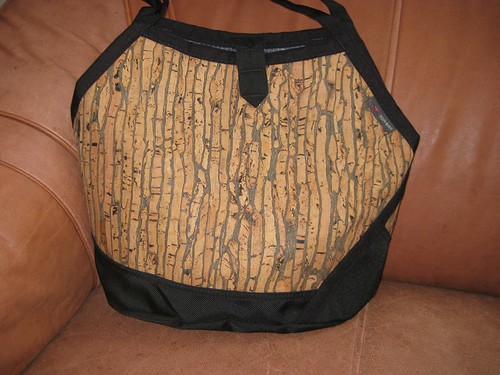
I tend to carry my knitting bag not only all around the house, but also out and about. Almost everywhere I go. I always have at least 2 projects in there, and my little finishing case, and the iPad. I use the iPad for all my patterns these days, so I don’t have to print them out. With all the changes I make while I knit, I’m sure I’ve saved lots of trees by refraining from printing. And I almost always have a book with me too. Just in case. And a couple of sheets of graph paper, and a pencil. And my new fingerless mitts so I don’t freeze while knitting in the arenas.
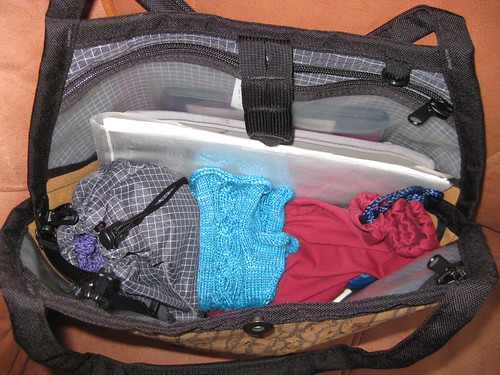 All that fits quite comfortably in the bag. It’s not overstuffed at all. I also really like the cork-fabric. It looks really neat, I think. And I’m told it will darken as it ages.
All that fits quite comfortably in the bag. It’s not overstuffed at all. I also really like the cork-fabric. It looks really neat, I think. And I’m told it will darken as it ages.
So far it’s been really good. The true test will come this weekend, when we’ll be going all over town for hockey practices and a special birthday dinner. 
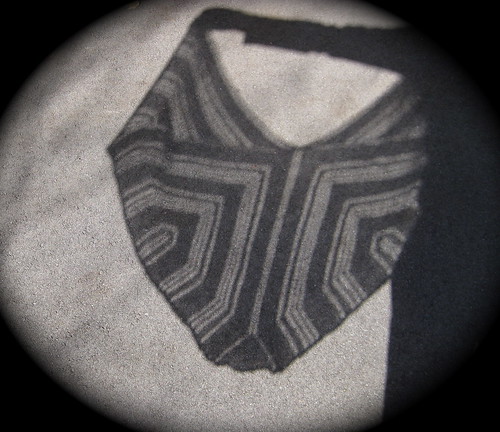
The ShaShaShawl came about while I was playing around with different shawl shapes. It’s a heart-shaped shawl, or a triangle with wings, which means that when it’s worn, the wings drape nicely over your shoulders, and the shawl stays in place.
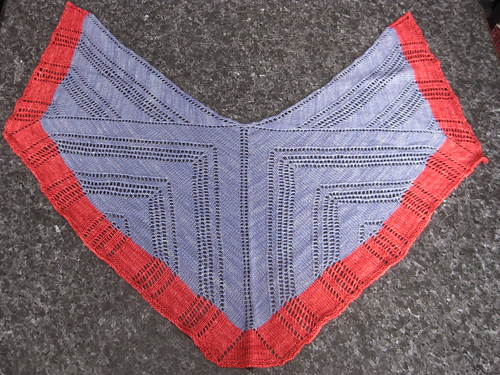
My shawl is knit in two contrasting colours of ShaSha – a light fingering weight yarn from Land O Lace. I wanted a contrasting colour to emphasize the border, but of course it could equally well be knit in one colour. The shawl is knit from the top-down, i.e. starting at the neck and working outwards towards the edging. The lace pattern is clean and crisp lines, to allow the yarn and the overall shaping to be the focus of the shawl.
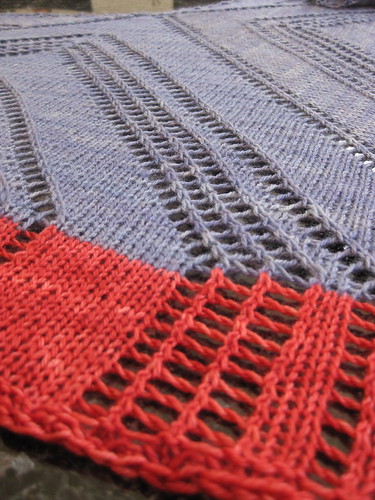 The pattern is available for download here as well as on Ravelry.
The pattern is available for download here as well as on Ravelry.
As part of the New Year inventory, I decided to take stock of my patterns and see which ones are the most popular.
The past month’s bestsellers have been:
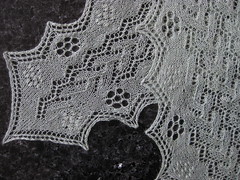
1. Seasons of Lace – Winter & Spring
3. Skuld
4. Urdr
All time best-sellers:
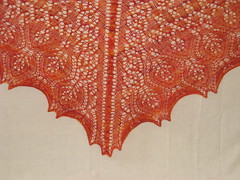 1. Mystic Light
1. Mystic Light
3. Mystic Star
5. Mystic Earth
Happy New 2011! I hope you’ll all have a wonderful year, filled with new knitting adventures.
During the holidays, I decided to take a small break from my usual lace knitting and knit something different for a change. Since hockey season started in the end of August this year, I’ve been wanting to design and make a pair of fingerless mitts, so that I can knit while the kids are at hockey practice, without freezing my hands off. So I finally decided to cast-on for that project.
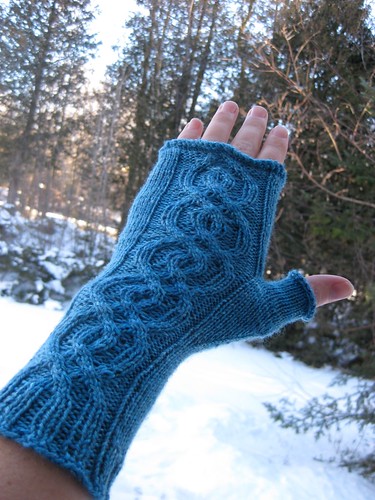 My fingerless mitts are knit from the finger-side down towards the cuff, and the thumb is knit afterwards in the opposite direction. There are no individual fingers on the mitt, because I think that would get in the way when I knit while wearing the mitts. I want to be able to snake the yarn between the fingers for even tension while I’m knitting, and I don’t want it to be caught on the mitts. The cable pattern reminds me of the marks left on the ice by skaters – perhaps more from figure skating than hockey games, ha ha, but the scratches left after a hockey game wouldn’t be quite as visually appealing.
My fingerless mitts are knit from the finger-side down towards the cuff, and the thumb is knit afterwards in the opposite direction. There are no individual fingers on the mitt, because I think that would get in the way when I knit while wearing the mitts. I want to be able to snake the yarn between the fingers for even tension while I’m knitting, and I don’t want it to be caught on the mitts. The cable pattern reminds me of the marks left on the ice by skaters – perhaps more from figure skating than hockey games, ha ha, but the scratches left after a hockey game wouldn’t be quite as visually appealing.
 The palm of the mitts is just plain stockinette, as I think that anything too patterned would be uncomfortable.
The palm of the mitts is just plain stockinette, as I think that anything too patterned would be uncomfortable.
I used Swiss Mountain Sea Sock from Handmaiden (51% silk, 29% merino, 20% seacell – 437 yds per 100 g) in Topaz and 2.25 mm needles for this project, and it knit up quite quickly over a couple of days and during some of the tournament games my kids played during the Christmas break. And now I’m ready for the rest of the hockey season and can knit my way through all the practices and games without getting so cold. I look forward to it!


Recent Comments